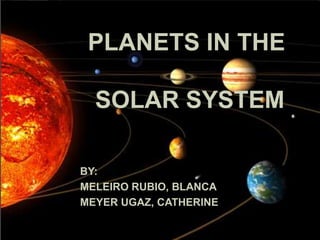
Planets in the solar system
- 1. PLANETS IN THE SOLAR SYSTEM BY: MELEIRO RUBIO, BLANCA MEYER UGAZ, CATHERINE
- 2. PAGES TERRESTRIAL PLANETS Introduction……………………………………..………..3 Mercury……………………………………….………. 4 ,5 Venus………………………………………….………..6, 7 Earth………………………………………………….…8,9 Mars………………………………………………… 10 ,11 GAS GIANT PLANETS Introduction……………………………………………. 12 Jupiter……………………………………….……… 13 ,14 Saturn……………….........................................…15 , 16 Uranus……………..........................................……17,18 2 Neptune………………………………………...……19 ,20
- 3. TERRESTRIAL PLANETS INTRODUCTION In our solar system , there are four terrestrial planets, which also happen to be the four closest to the sun: Mercury, Venus Earth and Mars. They are celestial planets and inner planets. They are all composed mostly of rock and heavy metals. This planets are much smaller than gas giants. Terrestrial planets are also 3 called rocky planets or telluric planets.
- 4. TERRESTRIAL PLANETS MERCURY Mercury is the smallest terrestrial body and the planet closest to the sun. Mercury has no moons. The interior of Mercury is probably made up mainly of the dense metal iron. 4
- 5. TERRESTRIAL PLANETS MERCURY Mercury is a dry, barren planet, because it has very little atmosphere. Also the diameter of Mercury is 4,878 km (3,030 miles)and the rotation period about axis is 58.65 days. The surface of the planet is covered with craters. 5
- 6. TERRESTRIAL PLANETS VENUS Venus is the second planet from the Sun. This gives it an orbital period of 225 days. The radius of Venus is almost exactly that of the Earth. 6
- 7. TERRESTRIAL PLANETS VENUS Is the brightest planet in the sky. The surface temperature on Venus is about 462 degrees Celcius. The atmosphere is made up mostly of carbon dioxide. There is liquid water and oxygen. 7
- 8. TERRESTRIAL PLANETS EARTH The Earth is the only planet known to have living things. Its atmosphere is composed mostly of oxygen and nitrogen. Earth is a rocky planet. 8
- 9. TERRESTRIAL PLANETS EARTH Is the only planet with a liquid surface, the water occupies 71% of the earth's surface. From the space the Earth looks blue,this is because of the oxygen of the atmosphere and the abundance of seas and oceans. 9
- 10. TERRESTRIAL PLANETS MARS Mars is the fourth planet from the Sun. Is much smaller than the Earth. The atmosphere on Mars contains only small amount of oxygen. Mars has two moons : 10 Deimos and Phobos.
- 11. TERRESTRIAL PLANETS MARS o The surface of Mars has impact craters, volcanoes…etc. o It has seasons, an approximately 24 hour day, and an atmosphere with clouds and icecaps. 11
- 12. GAS GIANT PLANETS INTRODUCTION Now, we are going to talk about the gas giant planets, also called the outer planets because they are the furthest planets from the Sun in the Solar System. 12
- 13. GAS GIANT PLANETS JUPITER The first gas giant planet is Jupiter. Jupiter receives its name from the roman god, Jupiter. It is the fifth planet and the biggest planet in the Solar System. It has got 13 satellites. It is covered by an atmosphere of liquid hydrogen. It is principally made of helio and hydrogen. 13
- 14. GAS GIANT PLANETS JUPITER It has a velocity of rotation higher than the velocity of rotation in the Earth. Jupiter only takes 10 hours to rotate on its axis. Something that is remarcable on the surface of Jupiter is the big, red spot. 14
- 15. GAS GIANT PLANETS SATURN The second gas giant planet is Saturn. Saturn is the sixth planet in the Solar System. It is similar in size as Jupiter but is slightly smaller. It is surrounded by a system of rings. It receives its name from the roman god, Saturn. 15
- 16. GAS GIANT PLANETS SATURN It is made in a 90% of hydrogen and in a 5% of helio. Saturn's atmosphere has a pattern of dark and light bands similar to Jupiter’s. Saturn has got a lot of satellites that orbit the planet. 16
- 17. GAS GIANT PLANETS URANUS The third gas giant planet is Uranus. Uranus is the seventh planet in the Solar System and the third biggest planet in the Solar System. Uranus receives its name from the greek god Uranus. 17
- 18. GAS GIANT PLANETS URANUS It has got the coldest atmosphere in the Solar System. Uranus has also got a system of rings and a lot of satellites surrounding the planet. Its axis of rotation is almost on the plane of its orbit. 18
- 19. GAS GIANT PLANETS NEPTUNE And finally, the fourth gas giant planet is Neptune. Neptune is the eight planet and the farthest planet in the Solar System. It receives its name from the roman god, Neptune. Now, we only know about 13 moons that orbit the planet. 19
- 20. GAS GIANT PLANETS NEPTUNE There is a big, dark spot on Neptune´s surface. The temperature on it is very low because of little heat that receives from the Sun but, some scientifics think, that Neptune has a heat source. Neptune has also got a tenuous system of rings. 20
- 21. 21
- 22. THANKS FOR YOUR ATTENTION 22